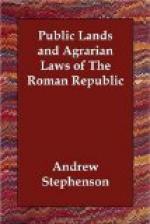the clerk of Trimalchio making a report of that which
has taken place in a single day upon one of the latter’s
farms near Cumae. Here on the 7th of the calends[6]
of July, were born 30 boys and 40 girls; 500,000 bushels
of wheat were harvested and 500 oxen were yoked.
The clerk goes on to say that a fire had recently
broken out in the
Gardens of Pompey, when he
is interrupted by Trimalchio asking when the
Gardens
of Pompey had been purchased for him, and is informed
that they had been in his possession for a year.[7]
So it appears that Trimalchio, in whom Petronius has
personified the pride, the greed, and the vices of
the rich men of his time, did not know that he was
the possessor of a magnificent domain. In another
place Petronius causes Trimalchio to say that everything
which could appeal to the appetite of his companions
is raised upon one of his farms which he has not yet
visited and which is situated in the neighborhood
of Terracina and Tarentum, towns[8] which are separated
by a distance of 300 miles. Finally, led on by
his immoderate desire to augment his riches and increase
his possessions, the hero of Petronius asks but one
thing before he dies,
i.e., to add Apulia[9] to
his domains; he, however, admits that he would not
take it amiss to join Sicily to some lands which he
owned in that locality or to be able, should envy not
check him, to pass into Africa[10] without departing
from his own possessions. All this has a basis
of fact. Trimalchio would never have been created,
had not the favorite freedmen of Nero crushed the
people by their luxury, debauches, and scandals.
But the condition of society pictured by Seneca and
Petronius is that of the first century of the Christian
era and might not be taken to represent the condition
of affairs in the second century B.C., had we not some
data which go to prove the concentration of property,
the disparity between classes, and the depopulation
of Italy within the same century as the Gracchi.
Cicero was not considered one of the richest men in
Rome, yet he possessed many villas, and he has himself
told us that one of them cost him 3,500,000 sesterces,
about $147,000.[11] Cornelia, the mother of the Gracchi,
had a country residence in the vicinity of Micenum
which cost[12] 75,000 drachmae ($14,000); Lucullus
some years afterwards bought it for 500,200 drachmae
($100,040). According to Cicero,[13] Crassus had
a fortune of 100,000,000 sesterces ($4,200,000).
This does not astonish us when we see upon the via
Appia, near the ruins of the circus of Caracalla
and but a short distance from the Catacombs of St.
Sebastian and the fountain of Aegeria, the still important
remains of the tomb of Caecilia Metella, daughter
of Metellus Creticus and wife of the tribune Crassus,
as the inscription testifies. It is a vast “funereal
fortress” constructed of precious marble, and
which gives us the first example of the luxury afterwards
so common among the Romans. Then, too, we remember
that Crassus was wont to say that no one was rich
who was not able to support an army with his revenues,
to raise six legions and a great number of auxiliaries,
both infantry and cavalry.[14]




